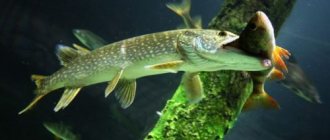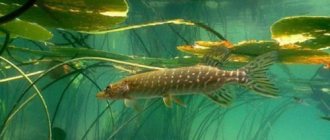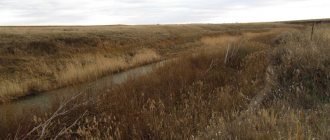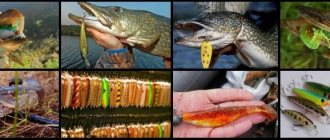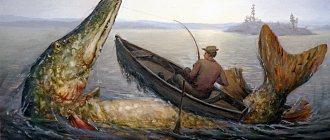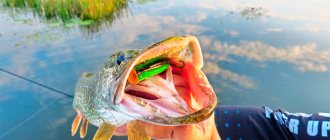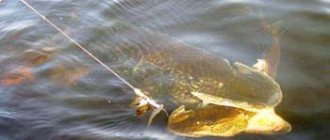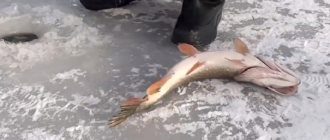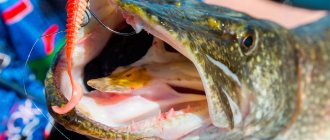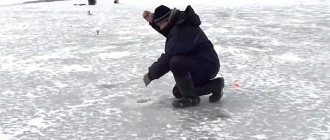Spring pike fishing is especially good in the post-spawning period. In the middle of nowhere, the best time for pike fishing is in the first half of May. Pike fishing in May has a number of features, which we will tell you about now. The main thing to remember is that fishing for pike in May is more successful in cloudy weather; it is better to catch pike in May using live bait. The best bait for catching pike in May is: dace, bleak, roach, and bream. Let's figure out where to catch pike in May, how to catch pike in May, and what fishing for pike in May will be more successful.
When and where to catch pike in May
Choose cloudy weather for post-spawning pike fishing. It is on quiet, cloudy spring days that you need to go to a shallow river that has cleared of melt water.
As a rule, pike begin to be caught using spinning rods a week or two after spawning.
Usually in the middle zone this time falls in the first half of May. From dawn to dark, pike are caught well because they are hungry. However, the most productive time for pike fishing in May is during the day. At night, the pike bite subsides, but you need to take into account that in each specific place the fish has its own biting schedule.
Peculiarities of pike behavior in May
Spawning of pike in the central and southern regions occurs at different periods, but by May it completely moves away from post-spawning passivity, which manifests itself within 2 weeks. In large bodies of water it approaches the coastal zone and rarely appears at depth. On small rivers and lakes, pike is found everywhere, but still more often it also hides in snags and thickets near the shore.
Potential prey for pike (small fish) is in the upper and middle layers of the water. A predator also lives here. High activity occurs throughout the daylight hours. Moreover, the air temperature does not have much effect on the fish’s appetite, but it is noted that the best bite occurs on cloudy days. The above nuances should be taken into account when planning to catch pike in May.
Pike fishing in May
Fishing for pike in May will be more successful if you take note of sereta bait for catching pike in May. After spawning, the pike is very hungry and is ready to swallow schools of fish swimming past a toothy barrier hidden in a bay or near a tributary. Pike bite worse on artificial bait in May, so it’s better to fish with live bait.
To obtain live bait, bloodworms or small maggots are useful. The place to fish for live bait is on small rivers where the flow stops. Fishing is done with a regular float rod. You need to take the smallest hook (No. 20-22), fishing line 0.15-0.18 mm. Preserving live bait in the spring is not difficult, but you should still remember to change the water in the container with live bait more often and not leave it in the sun to avoid overheating.
Fishing for pike with live bait - Bait for pike fishing in May
- the best live baits for catching pike in May are dace, bleak, roach, and bream;
- It is somewhat worse to catch pike in May using chubs, small perches and crucians;
- Very bad live bait for catching pike in May will be ruffs or tenches.
Where to look for pike in May
You need to start fishing for pike in late April or early May from overgrown bays and coastal strips with reeds, where the toothy fish spawned. Right there it settles and then eats until it gets completely warm and the bays dry up or turn into ankle-deep toad beds. This is both complex and simple - it depends on the configuration of the reservoir.
- In small rivers and ponds, lakes, the toothy can stand anywhere, in local shelters, and not just in the grass or next to it. But to a greater extent, of course, we focus on areas next to reeds and quiet warm bays, the border of thickets and clean water. You need to look for pike on small rivers in May in the same places as in the summer - in areas with medium and shallow depths, abounding in deviations in the relief.
- In large deep rivers and reservoirs there is definitely a coastal zone or shallow overgrown bays, irrigation. In both cases, we look for places without current with a spinning rod. On a fast-flowing river, first of all we check the quiet corners, backwaters and holes behind the cape.
- To catch pike in May on the pond, we go to the branches, upper reaches and nickels with sprouting young reeds. We also check local holes nearby with a jig - the pike can settle there and go out to the grass to hunt.
- Often, pike fishing in May on small rivers occurs without deviations such as zhora or complete lack of bite, especially in warm spring. There are already the usual cycles - like summer, searching for points and selecting bait. If spring is late, then the toothy one has just spawned, and if you often go to a pond with a spinning rod, you can observe the whole process of changes in its activity. Read more about standard pike fishing in summer and finding its ambushes.
- Catching pike in early May, a week after spawning, involves picking out individual passive predators that were nevertheless tempted by the bait. Nothing today - tomorrow a mad glutton may turn on. Then - a pause, after - resumption of nutrition.
By the end of May, the bite stabilizes and becomes cyclical. Activity cycles shift from daytime to morning and evening. Spinning fishing is already standard, searching for ambushes and selecting bait. If at first there were pike, including large ones, in a conditionally suitable reed-grass bay, this is no longer the case. Migrating fish slide down, and local fish occupy their usual ambushes. If it’s already warm and even hot, the water has gone – we’re looking for the toothy one in the usual summer places, but not far from the points where it took a spinning rod a little earlier.
General promising points for spinning for pike in May:
- When the water level is high, despite the fact that it is already warm, there is a border between clean and cloudy. Quiet corners, border of the bay and open water area.
- Actually, overgrown shallow waters and water areas with depths of up to 1.5 meters, wherever there are a lot of white fish. Shallow oxbow lakes, backwaters, floodplain lakes. Mouths of rivers and streams flowing into lakes or ponds.
- On large bodies of water without anomalies - the upper edges of shore dumps and navels.
- Local shelters are islands of thickets, mud, snags, fallen trees, spits in large bodies of water, access to shallow areas with unevenness on the bottom.
Tackle for pike fishing in May
Even if the flood is strong or the water subsides quickly, the pike will move throughout the entire reservoir and will certainly stumble upon any bait. The difficulty of catching pike in May is to get the hyperactive fish out of the water, because the first spawning of pike occurs at the age of three, when the fish weighs about a kilogram. Therefore, appropriate gear should be prepared for pike fishing in May:
- two-meter spinning rod;
- fishing line with a diameter of 0.27-0.35 mm;
- ten-centimeter composite steel leash;
- single or double wide twenty-millimeter hook;
- olive sinker weighing 10-20 g;
- corresponding float.
Tips for catching pike in the Zhabovnik
Also, as a special type of small forms, we can distinguish “toads”. They represent drying up or overgrowing water spaces of ponds, lakes, river estuaries, and so on. Here you can use heavy spinning equipment with bait up to 15 g and fishing line with a holding weight of up to 5 kg. Since there are individuals weighing no more than 3 kg.
Here is the basic composition of such simple methods of catching pike in May. When catching it during this period, you can easily sharpen your fishing skills for this predator or gain unique initial experience that will be useful to you in the coming summer and autumn.
The latter is fruitfully influenced by the ability to choose any available method of catching it, a wide range of choice of gear and bait. The luck in catching it is influenced by the manifestation of a strong zhora in the post-spawning period. In general, you can try everything.
So that your pleasure is not overshadowed by a hefty fine, always check the time and parameters of the fishing ban in the place where you decide to fish.
Tactics and techniques for catching pike in May
Before starting pike fishing in May, it is better to make several test casts to find out the topography of the bottom of the reservoir. Pike do not like very fast currents and therefore often lurk where spring flows wash out depressions. It is in such a place that the bait fish dragged along the bottom will begin to come to its senses, and the pike will rush at it.
However, it would be even more successful to lead the bait at a distance of 50-70 cm from the bottom. To do this, count while immersing the line in the water, and when throwing it again, stop at the count of 2 until the final number (it was 10, now it is 8).
The rod should be kept in line with the line to reduce the strain when jerking. A pike bite is transmitted to the rod as a strong blow, and the larger the fish, the stronger it is. After a bite, you can’t immediately hook the bait, but you need to let the fish swallow the bait.
If a large pike is caught, it will drag the bait into the depths from the shore. Such fish need to be hooked in 2-3 seconds. Small pike will swim first to the shore or along it. This fish should be given 10-15 seconds, and then pulled out of the water. The fish must be gently brought to the shore, trying not to let it make “candles” because in this case the pike often leaves the hook. A failed pike should be caught with a pre-prepared net, and a large one should be pulled out using a hook.
Pike fishing techniques on small rivers
When a friend and I come to a small river, so as not to press each other, we scatter - he goes downstream, I go up, both options are equivalent, because the pike on a small river is not particularly timid, as is sometimes assured that, they say that approaching the shore will alert the fish, and it will go downstream. Of course, some options for sufficient camouflage will not be superfluous, but only if they do not directly interfere with fishing. I myself don’t worry about hiding from pike. It used to be that I would stand almost at the water’s edge, on the bare shore, and casting about 10 meters, I would lift one, two, three... I even fished vertically from the tip of the spinning rod, the difficult conditions forced me to. For example, bushes hanging over the water along the shore cannot be thrown either from above or from below, but the place under the branches is good, especially in sunny weather. Or you can’t get the bait through a thick snag; even the unhooked baits get stuck. Then I simply approach an interesting place and vertically lower the jig head - the pike, like a submarine, rises from below and attacks, roughly speaking, three meters from me. In such cases, a short spinning rod of 2.1-2.4 m is good, it’s like a fishing rod - it’s convenient to work with a spinner with one hand, climbed out of a bush and waved, but with a three-meter rod it will be inconvenient. Although in other conditions of small rivers it is more convenient to use a long spinning rod - it is easier to move the fish away from the obstacle and to lead the bait further from the shore. No one carries two poles, but if I go with my son, we take rods of different lengths, his is 2.4 m, mine is 2.7 m, and everyone fishes points where his spinning rod length is appropriate.
Catching pike with a float rod
Catching pike with a float rod is not the most effective way, but it is no less interesting and is best suited for those who are not going to bother with a spinning rod and for those who do not have a boat. I’ll tell you how to successfully fish with a bamboo rod, 3.5 meters long, with a float made of large cork, the float must be able to withstand a gudgeon, or any other small fish that acts as live bait, the float should be loaded in such a way that the live bait can hardly drag the tackle , but could move halfway through the water, luring the predator with its movements.
Use a double “goat” hook, you can also use other hooks, but if the hook is not large and strong enough, then the broken pike will be on your conscience. Now the process of catching pike with a float rod, choosing a place and time, on which the success of the fisherman sometimes depends to a greater extent than on everything else.
Andrey Shalygin
What to use to catch pike in May?
Due to the activity of the fish and its significant appetite, it is ready to rush to a wide range of baits, which you can prepare yourself or buy in specialized stores. For her, the main factor is attractiveness and movement.
When it comes to hook bait, the only option is live bait. Almost all types of spinners are suitable for spinning fishing. They should represent an imitation of the fish that the predator hunts. Jigs are not very effective this time of year.
Read expert opinions
About the features of fishing described in the article
pike
About the features of the types of fishing described in the article
float fishing
spinning
Peculiarities of pike biting in May
Successful fishing for pike in May with a spinning rod can be expected if it has already spawned and has recovered from illness after spawning.
The water level and its transparency also greatly influence the bite.
Spawning
Pike spawns at water temperatures of 5 - 12 °C. In central Russia, spawning usually begins in the last ten days of March and lasts 2-3 weeks. After spawning for 1 - 2 weeks, the pike “gets sick” - it comes to its senses after spawning and gains strength. At this time, the fish practically does not feed and does not pay attention to even the most attractive bait.
Post-spawning zhor
And after the fish has recovered from the disease, the post-spawning diet begins, which lasts 1-2 weeks. If spawning began at the end of March - beginning of April, it falls exactly in the first half of May.
The post-spawning period is a great time to hunt for pike with a spinning rod. are actively feeding at this time and greedily grab almost any bait.
Fishermen who manage to seize the moment and get to the reservoir at this time are almost guaranteed good catches.
Timing of spawning in different types of reservoirs
It is worth noting that pike spawning occurs first in small and medium-sized rivers, then in large ones, and pike spawns last in ponds and lakes. And if, for example, a fisherman discovers that by the beginning of May the post-spawning feast on small rivers has already ended, then there is every chance of catching an active predator biting in large rivers and lakes. And if the fish in ponds and lakes are still sick after spawning, fishing on small and medium-sized rivers can already be very successful.
Flood and water clearing
The muddy water that spring floods bring can cause a lack of pike bite. The peak flood in the middle zone usually occurs in April. By May, the water noticeably brightens, becomes transparent, and the fish become more active. If the water is still cloudy, fishing is unlikely to bring good results. In this case, you can try to find bodies of clean water - lakes or small rivers.
Fishing for pike with a spinning rod in May - what to fish with?
Not all spinning baits are equally effective in May. The most optimal baits at this moment will be those that can provoke a predator - either with their game, or colors, or noise.
The following baits work great for pike in May:
- Small noise wobblers, weighted for long-distance casting from the shore. The colors of these baits can be very diverse. And those who believe that in May in clear water you should catch pike with wobblers of natural colors are wrong. Pike bites well on acidic options, sharp contrasting patterns and colors that you won’t find in nature. Just look at the combinations of orange and bright green, which are covered with black and white stripes - a sort of peacock, which the predator, however, is successfully caught in May.
Wobblers begin to work quite well for pike in May.
- Oscillating spoons with chrome and gold plated. These spoons, of which Williams is the most prominent representative, work very well during this period. Of course, the Williamses work on pike in other months of the year, but in May they are unrivaled. Cutting spinners, tube spinners, and active spinners like Red Devil and Abu Garcia also work great.
- During this period, the pike also does not ignore rotating spoons. Large Longs from almost any manufacturer work excellently. Of course, Mepps Aglia Long and all her clones work well in the Silver and Gold colors, as well as in any colors with flex.
Surface baits - poppers, sliders, gliders, prop baits and others - do not show themselves at all when fishing for pike in May using a spinning rod. This is due to the fact that the water is still too cold and small fish do not go to the upper layers in schools. At this moment the predator prefers to hunt in the water column. And even in shallow places where pike could be, it will not bite on surface baits.
The exception is meadows and irrigation that are flooded with spring waters at this moment. Where whitefish graze in large quantities, pike sometimes begin to react very actively to all surface baits.
Pike can also be caught using poppers and wolves in bays that are flooded and then isolated from the main body of water.
More on this topic on our website:
- Pike in November for spinning - where to look, what to catch Autumn is coming to an end, the first freeze-up is not far away, and the time for winter fishing is approaching. In some regions, the first strong…
- Fishing for pike in October with a spinning rod - how to catch October is an interesting month. From a fishing point of view, this is not summer at all and not even the beginning of the autumn spinning Eldorado….
- Catching pike in September with a spinning rod from a boat and the shore The calendar summer is over, it’s September. But the fact that school holidays and vacations have come to an end is not at all...
- Pike fishing - winter spinning When snow covers the banks and ice has not yet formed on the reservoir. When it’s November outside, but the temperature is still high during the day...
Fishing for pike in May with a spinning rod - where to look?
The only way to catch pike in May using a spinning rod is to look for clean areas of the reservoir where the water is still clear. In such water, on the border with muddy water, there are schools of feeding fish, which select particles of food from the turbidity. Turbidity enters the reservoir with streams and simply with spring streams, which, flowing from the banks, bring into the reservoir everything that is washed out of the soil along the way.
At this moment, the predator also stands on the border of muddy and light water and “grazes” food fish, like a wolf grazes a flock of sheep.
It is typical for any predator, be it perch, pike perch or pike, to choose water with the least amount of suspended dirt. Dirt and turbidity prevent any fish from breathing normally, clog the gills, and reduce activity.
Areas on the border between clear and muddy water work well in May.
Where can you find areas of clear water bordering areas of muddy water in May?
- Firstly, these are areas without a current on the border with relatively clean flows along the banks of a reservoir, where the water is not muddied by wind currents and the channel current does not carry dirt.
- Secondly, these are places where water flows from relatively small, settled bodies of water, such as swamps and forest streams. Forest reservoirs at the time of flood do not carry as much dirt as plain or mountain rivers.
- Thirdly, these are all kinds of isolated backwaters, bays and creeks in which the water, on the one hand, has warmed up, but, on the other hand, still does not mix with the water of the main reservoir.
Fishing for pike in May using a spinning rod in such places will be the most productive. To fish in such places, it is not necessary to go out on the water in a boat. All these places can be easily penetrated with spinning baits from the shore.
Pike fishing in May. Float tackle and its features for pike fishing in May
Pike fishing in May
May is a great time for pike fishing. Fishing for pike in May with float tackle. Cloudy days are especially catchy. It is in this weather that it is pleasant to catch pike on rivers that are completely free of ice and melt water. After spawning, the pike is very hungry and behaves carelessly and very actively, which only plays into the hands of anglers. You should go fishing in May during the day, when the pike begins to hunt. In the evening and morning the bite is much worse, although it all depends on the characteristics of the reservoir.
Is complementary food needed for pike or not?
Bait plays a very important role when catching a predator, since the bait that is intended for peaceful fish is not used. At the end of spawning, the pike is very hungry, so the best bait will be live bait. It is advisable to catch bait in the same reservoir where pike fishing will take place. Any small fish can be used as live bait. It is important to keep the bait fish fresh by regularly changing the water and keeping it out of the sun.
Is pike active after or before spawning?
The increased activity of pike is not only a pleasant moment, but also causes some difficulties when choosing gear. The fact is that it is very difficult to fight active fish. The average weight of a pike is usually about one kilogram, but it causes plenty of problems. The tackle must be durable, that’s a fact. You don’t need a particularly long rod; 2 meters with a fishing line of 0.25-0.3 mm will be enough. Float rods are not designed for heavy loads, but you can use a carp rod with float tackle. It is mandatory to have a steel leash in the equipment so that the pike does not leave with the bait. The hook can be either single or triple. The weight of the weight is selected depending on the float, which, in turn, is selected depending on the conditions on the reservoir.
How and what to catch pike with, fact or fiction!
Pike fishing begins with test casts in order to determine the bottom topography. It is also necessary to inspect the reservoir for the presence of snags and underwater thickets. Live bait must be cast in such a way that it does not stand still, but moves along the places where the pike ambushes. Fishing should be done not at the very bottom, but a little higher. The rod must be held so that it is in line with the fishing line. A pike bite looks like a strong jerk; you need to let it swallow the bait, and then you can hook it.
Pike on a hook, what to do?
If a large pike is hooked, it will try to go deeper, while small ones usually move along the shore. First, it needs to be worn out for a short time, after which it can be pulled out. It is important to fish out this predator smoothly, otherwise it may break the fishing line. You need to have a landing net with you, because even after the fish is pulled ashore, it continues to actively resist, and its sharp teeth can cause serious injury.
Float or spinning rod, which is better for catching pike in May?
Of course, such gear is not the most productive for pike fishing, but even it can give a lot of pleasant moments. After all, catching pike with a spinning rod is much easier than with a float rod, so the joy of the catch will be many times greater. And if the most significant fishing conditions are correctly observed, then everything will depend solely on the skills, knowledge and experience of the fisherman.
Features of fishing with spinning rod
This method of catching pike is quite productive with the right approach. Telescopic models work well. They are effective in areas with dense vegetation and are convenient for transportation and storage.
The optimal places for spinning are overgrown areas and places with fallen trees.
Not all spinning baits are good at this time of year. Only those that can attract fish through noise and color are considered effective.
Experienced fishermen often like to use the following types:
- noise wobblers;
- oscillating spoons;
- rotating spoons.
Topwater baits such as poppers and sliders are not recommended.
